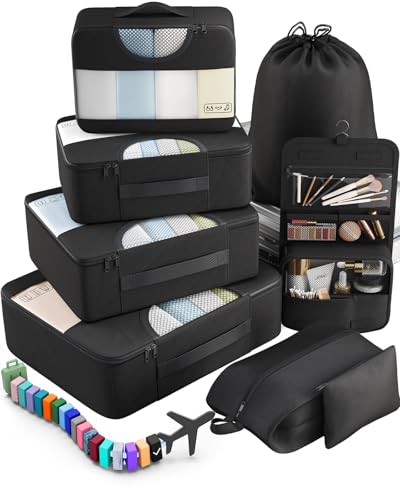In Adelaide, they use Type I power plugs and outlets. The voltage is 230V, and the frequency is 50Hz.
So, you’ll need a travel adapter in Adelaide. Their plugs and outlets are different from the Type A and B ones we use back in the States.
Quick Overview of the Plugs in Adelaide:
- Plug type in Adelaide: I
- Standard voltage: 230V
- Frequency: 50Hz
- Need a travel adapter? Yes, you do need a travel adapter
- Need a voltage converter? Some devices need it, others don’t
- Recommended plug adapter: Vintar Universal Travel Adapter Kit
This page combines official data from local electricity agencies, international IEC standards, and firsthand experiences shared by travelers who recently visited these countries.
The Only Travel Adapter You’ll Need in Adelaide
Don’t let the wrong adapter ruin your trip. We don’t sell them, but we’ve done all the research to find the best one for Adelaide—so you can charge up stress-free. Here’s the one we recommend:
Recommended Travel Plug Adapter
by 1,000+ travelers on Amazon
Already out there and forgot your power adapter? You’ll most likely be fine—there are usually options around. But next time, packing your own saves you the trouble and ensures you’ve got something reliable.
Adelaide is commonly visited along with New Zealand, Fiji, or Papua New Guinea. Double-check outlet compatibility.
Power Outlets in Adelaide
In Adelaide, they use Type I power plugs and outlets.
Type I

Type I outlets have two flat prongs in a V-shape with a grounding pin and accept both grounded and ungrounded Type I plugs; some ungrounded Type A plugs may fit with an adapter, but grounding will be lost.
Do You Need a Voltage Converter?
Planning a trip to Adelaide? The voltage there doesn’t match the 120V we use in the U.S., so you’ll probably need a voltage converter.
To avoid electrical issues, always check the voltage specifications on your device’s label before heading abroad. If it reads “100-240V, 50/60 Hz”, your device is dual voltage and can handle both 120V and 220-240V without requiring a converter. Most laptops, tablets, cameras, and smartphones have this feature.

Which Travel Devices May Need a Converter?
Play it safe with your electronics — browse the most trusted voltage converters here.
| Device | Need Converter? | Notes |
|---|---|---|
| Phone | ❌ No (usually) | Most modern phone chargers are dual voltage (100–240V) |
| Laptop | ❌ No (usually) | Check the power brick label for 100–240V |
| Hairdryer | ✅ Yes (often) | High wattage; many models are not dual voltage |
| Electric toothbrush | ⚠️ Check voltage | Some models are 110V only |
| Camera / DSLR | ❌ No (usually) | Most chargers are dual voltage |
| Power bank | ❌ No | Charges via USB, adapter is enough |
| Electric shaver / trimmer | ⚠️ Check voltage | Older or cheaper models may not support 230V |
| Tablet / iPad | ❌ No | All models are dual voltage |
| Portable fan | ✅ Yes (sometimes) | Many models are not compatible with 230V |
| Game console | ⚠️ Check voltage | Newer consoles like PS5 and Xbox are often dual voltage — check to be sure |
| Bluetooth speaker | ❌ No (usually) | Charges via USB |
| E-reader (Kindle, etc.) | ❌ No | USB charging only, no converter needed |
Top Travel Essentials to Pack
You’ve got your adapter—great. But here are a few more essentials that frequent travelers swear by. They’re small, but seriously useful.
Digital Luggage Scale
Packing Cubes
Power Bank
More About Adelaide
Adelaide is often called “Australia’s secret capital”—charming, easy to walk around, and packed with character without the big-city crowds. The city is famous for its Central Market, one of Australia’s oldest indoor produce markets, where nearly a million pounds of fresh food comes through each month, and where visitors come to eat, shop, or just soak up the local energy. The surrounding hills and nearby wine regions—like Barossa Valley, McLaren Vale, and Adelaide Hills—are just a short drive away. You can roll into a winery for tastings without a reservation, sip world-class shiraz, and stroll through vines under open skies.
Adelaide has more than 700 churches, giving it the nickname “City of Churches”—and the architecture runs the full spectrum from Greek revival to Victorian grandeur. Despite past bushfire impacts, the city and nearby Kangaroo Island have rebounded, emphasizing authentic wildlife viewing and sustainable tourism practices. Outdoor lovers will find coastline beaches rivaling Bondi and hiking paths winding through rolling southern ocean cliffs. With clean tram lines, quiet neighborhoods, and safe streets, Adelaide offers a relaxed yet vibrant entry point into South Australia.
For U.S. travelers, Adelaide delivers style and pace without pretension. English is standard, taxi rides and public transport are straightforward, and downtown is easy to navigate on foot. The food scene blends local produce with trendy café culture, and lodging ranges from boutique hotspots to relaxed B&Bs near the coast. Whether you’re unwinding in wine country, visiting markets, or watching the sunset over Glenelg Beach, Adelaide feels like a welcoming local city worth sticking around for more than a day.
Adelaide uses the same plugs and outlets as the rest of Australia.




